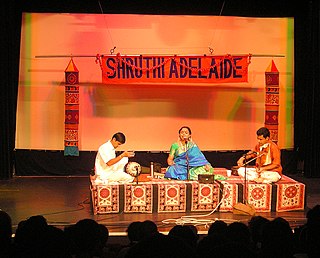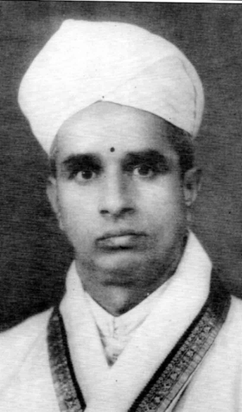Professor N. Ramanathan (born 1946) is a musicologist in India. He taught and guided research in the Department of Indian Music at the University of Madras since 1978, and retired in 2004.
Professor N. Ramanathan (born 1946) is a musicologist in India. He taught and guided research in the Department of Indian Music at the University of Madras since 1978, and retired in 2004.
He obtained a bachelor's degree in Violin (South Indian Art Music) from Sri Venkateswara University, Tirupati, and obtained his master's and Ph.D. degree in musicology at the Banaras Hindu University, Varanasi.
He has produced many publications and has presented papers at seminars on the Sangita Ratnakara and the Brhaddesi.

A raga or raag is a melodic framework for improvisation in Indian classical music akin to a melodic mode. The rāga is a unique and central feature of the classical Indian music tradition, and as a result has no direct translation to concepts in classical European music. Each rāga is an array of melodic structures with musical motifs, considered in the Indian tradition to have the ability to "colour the mind" and affect the emotions of the audience.

The shruti or śruti[ɕrʊtɪ] is the smallest interval of pitch that the human ear can detect and a singer or musical instrument can produce. The concept is found in ancient and medieval Sanskrit texts such as the Natya Shastra, the Dattilam, the Brihaddeshi, and the Sangita Ratnakara. Chandogya Upanishad speaks of the division of the octave in 22 parts.
The chitravina is a 20 or 21-string fretless lute-style veena in Carnatic music. Around the late 19th and early 20th centuries, it started to be known by another name, Gotuvadyam, which was bestowed upon it by Sakha Rama Rao from Tiruvidaimarudur, who was responsible for bringing it back to the concert scene.

Madras Music Academy is one of the earliest established music academies in South India. Before the concept of infrastructure was introduced to India in the early 1920s, it was a gathering for elite musicians simply called Music Academy It plays an important role in encouraging and promoting primarily the Carnatic Music Indian art form. It played a vital role in the revival of the Indian classical dance form of Bharatnatyam in the 1930s when it faced near extinction due to a negative connotation caused by conservative societal standards.

Ariyakudi Ramanuja Iyengar, popularly known as Ariyakudi, was a Carnatic music vocalist, born in Ariyakudi, a town in the present-day Sivaganga district of Tamil Nadu. Ariyakudi developed a unique style of singing which came to be known as The Ariyakudi Tradition and is followed by his students. He is credited with establishing the modern katcheri (concert) traditions in Carnatic music.

The Sangita-Ratnakara, संगीतरत्नाकर,, literally "Ocean of Music and Dance", is one of the most important musicological texts from India. Composed by Śārṅgadeva (शार्ङ्गदेव) in Sanskrit during the 13th century, both Carnatic music and Hindustani music traditions of Indian classical music regard it as a definitive text. The author was a part of the court of King Simhana of the Yādava dynasty whose capital was Devagiri, Maharashtra.
Śārṅgadeva (1175–1247), also spelled Sharngadeva or Sarnga Deva, was the 13th-century Indian musicologist who authored Sangita Ratnakara – the classical Sanskrit text on music and drama. It is considered to be the authoritative treatise in Indian classical music by both the Hindustani music and the Carnatic music traditions.

Parakkal Unnikrishnan is an Indian Carnatic vocalist and playback singer.
The Vijayanagara musicological nonet or the Sangitashastra navaratna are a group of nine musicological treatises written during the reign of the Vijayanagara empire. These works are counted among the most important and definitive treatises in Carnatic music theory. Each of these works contributed seminally to the growth of the Carnatic music tradition. These nine works are the Sangitasara by the sage Vidyaranya, Taladipika by Salva Gopa Tippendra, Sangitakalanidhi by Kallinatha, Bhandaru Vittaleshwara's commentary on the Sangita Ratnakara, Bhandaru Lakshminarayana's Sangitasuryodaya, Achyutadevaraya's Talakalabdhi/Talakalavriddhi and the much celebrated Swaramelakalanidhi by Ramamatya.
Manjapara Devesa Bhagavathar Ramanathan was a Carnatic music composer and vocalist who created a distinctive style of singing rich in Bhava and Laya. He was considered for the Madras Music Academy's Sangeetha Kalanidhi award in 1983.
Swaramelakalanidhi is a much celebrated musicological treatise of 16th century Vijayanagara. Authored by Ramamatya in the year 1550, the work is counted among the sangita shastra navaratnas or the nine 'gems' of the theory of Carnatic Music. The work's importance lies in the fact that it is more relevant and related to modern practice than the books written prior to it. Spread over five chapters, it deals primarily with the theory of raga, describes the melas for the classification of raga -and the different shuddha svaras and vikrta svaras constituting the melas.
Venkatamakhin or Venkatamakhi, was an Indian poet, musician, and musicologist of Carnatic music. He is renowned for his Chaturdandiprakashika in which he explicates the melakarta system of classifying ragas. Venkatamakhin composed geethams and prabandhas, as well as 24 ashtapadis in praise of Lord Thyagaraja of Tiruvarur.
S.R.Janakiraman is a Carnatic vocalist and a musicologist. He is a recipient of several awards including the Sangita Kala Acharya, Kalaimamani from the Tamil Nadu Government and the Sangeet Natak Academy Award of the Government of India and the Padma Shri.
The Rudrapatnam Brothers are an Indian Carnatic vocal duo, consisting of brothers R. N. Thyagarajan and Dr. R. N. Tharanathan. The brothers come from a family of musicians from Rudrapatna village off the Kaveri banks in Arkalgud Thaluk of Hassan district in the southwest Indian state of Karnataka. Vocalist Tiger Varadachariar, on seeing the musical atmosphere there, once claimed that "Rudrapatnam is the Thanjavur of Karnataka". Music, Veda adhyayana, and studying Sanskrit were integral parts of their family tradition.

Asaveri (asāvēri) is a rāgam in Carnatic music. It is a janya rāgam from the 8th melakarta scale Hanumatodi. It is a janya scale, as it does not have all the seven swaras in the ascending scale, and has a vakra (zigzag) descending scale.

Gaula or Gowla is a rāgam in Carnatic music. It is a janya rāgam from the 15th melakarta scale Mayamalavagowla. It is a janya scale, as it does not have all the seven swaras in the ascending and descending scale.
Sangeeta may refer to:

Pichu Sambamoorthi (1901–1973) was an Indian musicologist, writer and the professor of musicology at the Sri Venkateswara University, Tirupati. He was the author several books on music, including A Dictionary of South Indian Music and Musicians, Great composers, South Indian Music, Sruthi Vadyas (Drones) and Laya Vadyas: Time-Keeping Instruments. He was awarded the Madras Music Academy's Sangeetha Kalanidhi in 1972. The Government of India awarded him the third highest civilian honour of the Padma Bhushan, in 1971, for his contributions to music. He was also a 1963 recipient of the Sangeet Natak Akademi Fellowship.

R. Sathyanarayana was a musicologist and dance scholar from Mysore, India. In 2018, Sathyanarayana received the Padma Shri civilian honour from the President of India for his contribution to the field of music.
T. K. Govindarao was the first Malayali film musician and a Carnatic musician.